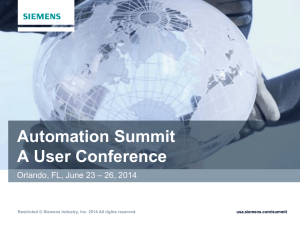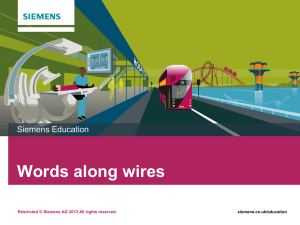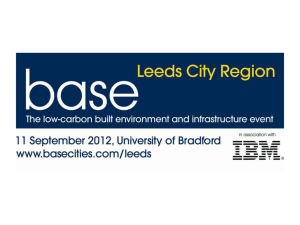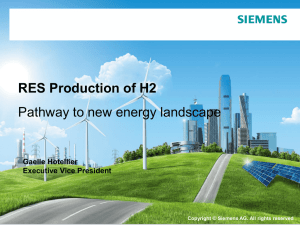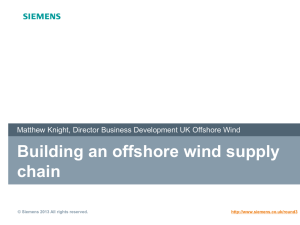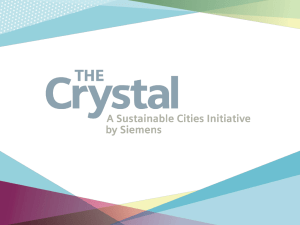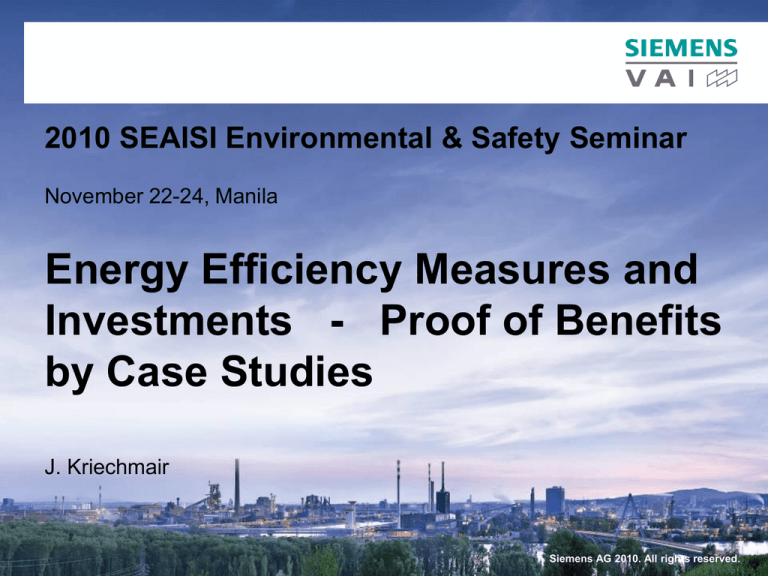
2010 SEAISI Environmental & Safety Seminar
November 22-24, Manila
Energy Efficiency Measures and
Investments - Proof of Benefits
by Case Studies
J. Kriechmair
© Copyright Siemens AG 2009
Siemens AG 2010. All rights reserved.
Technological innovations play a key role in increasing
energy efficiency and avoiding GHG emissions
Siemens makes a substantial contribution to environmental protection with its
energy-efficient products and solutions and its renewable energy and
environmental technologies.
What does Siemens offer? Some examples:
• Siemens Combined Cycle Power Plants: efficiency > 60 %
• Over 6,400 wind turbines, peak performance 5,700 MW
• High voltage direct current transmission technology:
2000 km transmission with minimum loss
• Variable speed drives for frequency converters: 60 %
energy reduction
• COREX technology reduces CO2 emissions by 30 %, SO2
emissions 97 %
• Breaking energy recovery applied at Subways
• Optimizing HVAC at 6,500 buildings -> 2.4 million t CO2
reduction
• For lighting: LEDs use 80 % less electricity than lightbulbs,
50 times longer service life
© Copyright Siemens AG
Page 2
17 – 19 June 2009
Metals Symposium 2009
Author: asdfjklö
I IS MT
Energy – including reducing agents – is a major
source for costs of iron & steel production
Production costs for hot rolled coil
Energy is a major cost driver – example
integrated steel plant
($/t)
~ 400
24%
145
10%
Other
18%
36%
Energy Cost
Development and Forecast
Index = 100 in 2004
Electricity
Thermal energy
(mainly from
natural gas)
250,00
Forecast
Forecast
200,00
Energy
sources
150,00
72%
40%
Reducing
agents
(mainly coke)
Ferrous
raw materials
100,00
50,00
Total
cost
Energy
costs
1. Contains all credits for by-products
Source: Company data; BCG analysis
Page 3
November, 2010
Coking coal cost
Electricity cost
Natural gas cost
Source: CRU
Efficiency improvements one way to counter-balance
energy cost impact
Johann Kriechmair
MT MP IP DP, Siemens VAI Metals Technologies GmbH
Confidential / Copyright by Siemens VAI
Existing plants show considerable differences in
energy intensities – a key to improvement potentials
Typical energy intensities (in GJ per ton of output material)
Typical energy intensities (in GJ
per ton of output material)
“Top performers”
“Medium”
~3.5
Coking
~4.3
~1.5
Sintering
~7.7
~1.7
~14.8
Iron-making
(BF)
“High saving
potential”1
~3.3
~17.4
~22.2
Steel-making
(BOF)
~0.2
~0.3
~0.7
Casting
~0.1
~0.2
~0.3
(CC)
Hot rolling
~1.6
~2.1
~3.6
(HSM)
Cold rolling
Finishing
~0.3
~1.1
~0.4
Top performers
~1.4
~0.6
Additional energy usage
for medium performers
~2.4
Additional energy usage
for low performers
Different plant preconditions (size, input materials etc.) to be
taken into account when comparing different sites
1. Not accounting for outdated technology, such as open hearth and ingot casting
Source: SVAI, BCG
Page 4
November, 2010
Johann Kriechmair
MT MP IP DP, Siemens VAI Metals Technologies GmbH
Confidential / Copyright by Siemens VAI
Energy savings can be realized by existing, proven
technologies
Siemens MT green solution examples
• COREX/FINEX
• Reheating Furnace
Process Optimization
• Mill pacing
• Top gas recovery turbine
• Improved automation
• Gimbal top charging system
• Coke dry quenching
• Process mgmt. system
Auxiliary
plants
power plant
• Drive efficiency and
controlled drives
• Roll gap lubrication
LDG
Scrap
COREX FINEX
Coking
Coal
Coke oven
gas
Coke
Oxygen, etc.
Molten
steel
Hot rolled
products
BFG
Sinter
Cold rolled
products
Ladle
Furnace
Coke oven
Ore
Hot
metal
Sintering plant
Hot
stove
•
•
•
•
Blowers – VVVF
Automation
Waste gas recycling
Waste heat recovery
Blast
furnace
• Process
Optimization
• Stove heat
exchanger
Continuous
Caster
Basic oxygen
furnace
Reheating
furnace
Hot
rolling
Cold
rolling
Processing
Lines
RH
•
•
•
•
• Balanced drive
operation
Dry dedusting
Waste heat recovery
BOF gas recovery
Process Optimization
ESP
• Demand-driven utilization of
ancillary unit
• ISP/ESP1
Efficient Energy Supply, Net Optimization
Energy Management & Control Systems, Cross Process Optimization
Page 5
November, 2010
1. Endless Strip Production
Johann Kriechmair
•New technology
MT MP IP DP, Siemens
VAI Metals Technologies GmbH
•Proven technology
Confidential / Copyright by Siemens VAI
Environmental improvements both by end- of-pipeand primary process technology
Siemens MT green solution examples
Dry gas cleaning
• DDS-Bag filter
• Hot cyclones
Residual treatment
• Slag granulation
Recycling
• Sludge
granulation
• COREX
• FINEX
Wet gas cleaning
• COG treatment
Dry gas cleaning
• CDQ dust removal
• CDQ gas cleaning
Residual treatment
• Biol. waste water
treatment
Recycling
• Coke dust
power plant
Auxiliary
plants
LDG
Scrap
COREX FINEX
Coking
Coal
Dry gas cleaning
• DDS-ESP
Coke oven
gas
Coke
Oxygen, etc.
Molten
steel
Hot rolled
products
BFG
Sinter
Cold rolled
products
Ladle
Furnace
Coke oven
Ore
Hot
metal
Sintering plant
Hot
stove
Blast
furnace
Dry gas cleaning
• MEROS
• DENOX
New process
• EPOSINT
Page 6
November, 2010
1. Endless Strip Production
Basic oxygen
furnace
Wet gas cleaning
• SVAI CONE
Dry gas cleaning
• Pulse-Jet-Filters
Residual treatment
• Pelletizing / Briquetting
Recycling
• CONTOP
• Zero waste concept
Johann Kriechmair
Continuous
Caster
Reheating
furnace
• OXITERM (De-oiling)
Hot
rolling
Cold
rolling
Processing
Lines
• CWC -Coating Weight Control
• Dynamic Air Knife ControlDAK
• FAPLAC – Automatic Pickle
Liquor Analysis and. Control
•New technology
technology
MT MP IP DP, Siemens•Proven
VAI Metals
Technologies GmbH
Confidential / Copyright by Siemens VAI
SIMETAL Selective Waste Gas Recirculation System
reduce coke demand and waste gas volume
Sinter process has a significant energy
demand, i.e. coke, and produces a high
Challenge
amount of waste gas
Solution
Environmental
benefit
Page 7
Reduction of waste gas volume
up to 40%
up to 10% less CO2 emissions
Decrease sinter plant emission
(SOx, NOx and dioxins) by
recirculation
November, 2010
Johann Kriechmair
re-circulate part of the off-gas from
selected wind-boxes back to the sinter
process
Decrease of coke consumption up to
10% due to heat and CO recirculation
Typical
customer
benefit
Higher sinter quality
Increase production
Less investment costs for waste gas
cleaning plant
MT MP IP DP, Siemens VAI Metals Technologies GmbH
Confidential / Copyright by Siemens VAI
SIMETAL Gimbal Top - Blast Furnace Charging
reduce coke rate, increase productivity
Distributing burden materials to the
furnace stock line
Challenge with high operational flexibility
enhance furnace operation
minimize maintenance costs
Simple, rugged, lever mechanism
Solution
Proven operation
Improved distribution control
Infinite charging flexibility
Environmental
benefit
Reduced CO2 emissions due
optimized furnace operation
Reduction of fume emissions due
to pressurized charging system
Typical
customer
benefit *)
Reduce fuel rates 15-25 kg/thm
Increase production > 5%
Improve service life
Improve gas utilization > 50%
Reduce heat load
Increase furnace campaign > 40%
*) when compared with bell-top
Page 8
November, 2010
Johann Kriechmair
MT MP IP DP, Siemens VAI Metals Technologies GmbH
Confidential / Copyright by Siemens VAI
Blast furnace top gas pressure recovery turbines
(TRT) generate electricity from top pressure
recover the potential energy in highpressure furnace off-gas
Challenge
Achieve a safe level for clean-gas
pressure
“bump-less” transfer of system pressure
during an unexpected TRT stoppage.
Solution
turbine construction suitable for BF offgas with the ability to control the turbine
blades for varying gas inlet conditions
inclusion of quick-acting valves for a
change in operation
Environmental
benefits
Page 9
Generate ~ 30-40 kWh/tHM
electric energy from blast furnace
top pressure
November, 2010
Johann Kriechmair
Typical
customer
benefit
Reduced electrical energy purchased for
the site or new energy sold into a local
grid
Ease of bringing the TRT ‘On-’ and ‘Off-’
line
MT MP IP DP, Siemens VAI Metals Technologies GmbH
Confidential / Copyright by Siemens VAI
Blower House for Blast Furnace
Key features and benefits
High energy demand for blast furnace
cold wind (up to 40MW and more)
Existing facility with low efficiency
Challenge No spare parts available
Highest degree of efficiency
Greenfield or Brownfield environment
Solution
Baosteel COREX® C-3000
Cost and energy saving due high
equipment and system efficiency
- High blower efficiency 85-90%
Environmental
benefit
- Total energy savings up to 50%
- Reduce CO2 emissions
- Save water consumption
Page 10
November, 2010
Johann Kriechmair
Electro or turbine drive
Customer-oriented compressor solution
Compaction of high volume flows within
a relatively small enclosure
Modular and robust machine design
Meets API Standards
Typical
customer
benefit
Low operating and maintenance costs
Extended operating range
Prevention of wear due to optimized
material selection
MT MP IP DP, Siemens VAI Metals Technologies GmbH
Confidential / Copyright by Siemens VAI
SIMETAL DDS BOF steelmaking plant primary dedusting
Dry type converter waste gas treatment with low consumption
figures
Challenge
Solution
Environmental
benefits
Page 11
High dedusting efficiency clean gas dust
content < 30 mg/Nm3
CO-gas recovery 70-90 Nm3/CO tsteel
Low specific consumption figures 3 kWh/t
– Low pressure loss because of
advanced design
– No waste water treatment plant
November, 2010
Johann Kriechmair
Typical
customer
benefit
CO rich hot fumes with high dust content during
oxygen blowing cycle
Gas temperature up to 1600 °C
Dust content up to 20 g Nm3
Suppressed combustion
Cooling stack (steam or pressured water cooled)
Evaporation cooler with dry dust separator
Electrostatic precipitator (compact design)
High plant availability
Low specific consumption figures (50% in
comparison wet dedusting)
Clean gas dust content < 30 mg/Nm3
No water treatment plant
Conform to best availade technology
Dry dust separation
MT MP IP DP, Siemens VAI Metals Technologies GmbH
Confidential / Copyright by Siemens VAI
BOF Gas Recovery
cut energy costs by utilization of steel making gas
By-product of LD-process:
80 Nm³/t steel of CO-rich
Challenge
converter gas
Solution
BOF gas recovery is a completely
integrated economic
and ecologic solution for BOF primarywaste-gas treatment
Typical
customer
benefit
Baosteel COREX® C-3000
Environmental
benefits
Page 12
Reduction of CO2 emissions
0.032 t CO2/ t steel
Substitution of fossil fuels
Total emission reduction
November, 2010
Johann Kriechmair
Energy savings of 0.57 GJ/t steel
Reduction of energy costs
Higher degree of efficiency
Short pay-back time
MT MP IP DP, Siemens VAI Metals Technologies GmbH
Confidential / Copyright by Siemens VAI
EAF Optimization
Reduce energy consumption and tap-to-tap time
Challenge
Increasing demands to lower production
costs and increase product quality
Insufficient process standardization
High productivity requirements with
minimum operator personnel
Solution
Well proven automation system for high
quality at low production costs
Dynamic process models
Modular-designed, expandable and
upgradeable automation package
Typical
customer
benefit
Reduce energy consumption up to 3%
Reduce tap-to-tap time due to standardized production practice up to 5%
Reduction of OPEX by up to 5%
Baosteel COREX® C-3000
Environmental
benefit
Page 13
Reduced CO2 emissions due to
efficient carbon usage
Lower consumption of raw
materials and resources
Efficient oxygen injection
November, 2010
Johann Kriechmair
MT MP IP DP, Siemens VAI Metals Technologies GmbH
Confidential / Copyright by Siemens VAI
SIMETAL SIMELT Electrode Control System
Real improvement for electric arc furnaces
Environmental
benefit
Page 14
Reduced CO2 emissions due to
lower specific electricity
consumption
Reduced impact on utility grid and
environment
Lower consumption of resources
November, 2010
Johann Kriechmair
Challenge
Dynamic control for fast electrode
movement and stable arc conditions
ensure precise and stable adjustment of all
EAF operating points
sustainable performance combined with
low usage of resources and consumables
Solution
Modular and multifunctional digital control
system based on SIMATIC S7
Proven, neural network optimized dynamic
impedance control with add-ons, system
analyzer and visualization
Melt down recipes for high repeat accuracy
and stable process conditions
Typical
customer
benefit
Reduced electrode consumption, ~ -5%
Increased effective power efficiency
(+10%) leads to reduced specific melting
power (-4%)
shorter power-on times (-12%) and
reduced down times (<50%) resulting in
higher productivity, e.g. +15%
MT MP IP DP, Siemens VAI Metals Technologies GmbH
Confidential / Copyright by Siemens VAI
SIMELT Foaming Slag Manager
Real improvement for electric arc furnaces
Challenge
to introduce fully automated foaming slag
process
to detect and indicate the foaming slag
height
to ensure uniform distribution of the
foaming slag in all furnace sections
to control and optimize carbon injection
Solution
with SIMELT FSM the foaming slag
process is fully automated
Body sound sensors are the base for
precise detection and slag height analysis
sectional and electrode related slag
detection with automatic carbon injection
Typical
customer
benefit
Controlled and optimized foaming slag
process
Reduced specific electric energy (up to 3%)
and carbon consumption (up to 25%),
Shorter power-on times, 1 min or even
more
increased productivity, 2% or more possible
Baosteel COREX® C-3000
Environmental
benefit
Page 15
Reduced CO2 emissions due to
lower carbon and energy
consumption, e.g. up to 10.000 t
CO2/year at 100 t EAF
savings in specific electric energy
consumption up to 3%
November, 2010
Johann Kriechmair
MT MP IP DP, Siemens VAI Metals Technologies GmbH
Confidential / Copyright by Siemens VAI
Furnace Optimization
Reduced fuel consumption – improved quality
Hot rolling operations need high-quality
reheated slabs, billets, or blooms at the
lowest possible cost, at the mill’s optimal
Challenge
production rate, with minimal impact on
the environment.
Solution
Environmental
benefit
Page 16
Reduced fuel consumption
resulting in lower environmental
emissions (CO, CO2, NOX, SOX)
November, 2010
Johann Kriechmair
Typical
customer
benefit
SIROLL Furnace Optimization delivers
optimally heated pieces to hot rolling
operations while minimizing fuel
consumption.
Fuel usage reduced by 6 to 15%
Discharge temperature deviation from
target < 1%
Improved surface quality
MT MP IP DP, Siemens VAI Metals Technologies GmbH
Confidential / Copyright by Siemens VAI
SIROLL Work-roll lubrication
increase surface quality, reduce energy demand
Energy is a main cost driver approximately 40% of conversion costs
Challenge
in rolling mills are energy charges
Solution
Baosteel
COREX®
Work-roll lubrication is dedicated to
reduce roll wear and friction of the work
rolls by application of lubrication media
in finishing mill stands
Less friction leads to reduced rolling
force and thus energy consumption
C-3000
Saving costs (roll wear and energy)
Environmental
benefit
Page 17
Significant reduction of electrical
energy demand - up to ~15%
November, 2010
Johann Kriechmair
Typical
customer
benefit
Improve strip surface quality
Extending the mill availability
Extending the mill limits
MT MP IP DP, Siemens VAI Metals Technologies GmbH
Confidential / Copyright by Siemens VAI
SIROLL Endless Strip Production
First casting-rolling plant for ultra-thin HRC
Production of ultra-thin high-quality steel
grades
Challenge
Reduction of power requirements and
emissions
Satisfy current and future market
demands
Fully continuous strip production
Solution
Outstanding production capacity
Most compact line layout
Baosteel COREX® C-3000
Environmental
benefit
Page 18
- 45% energy
- 50% CO2
- 50% length (190 m)
November, 2010
Johann Kriechmair
Typical
customer
benefit
High volume production of ultra thin strip
High quality strip
Lowest conversion costs from liquid
steel to Hot rolled coil
MT MP IP DP, Siemens VAI Metals Technologies GmbH
Confidential / Copyright by Siemens VAI
Real Endless Strip Production
Advantages of Inductive Heating
Only 10 Meter inductive heating leads
to reduced scale losses compared
to min. 200m tunnel furnace
No Energy consumption during idle
and maintenance periods
Energy Consumption [kWh/t]
500
fuel gas
electricity
400
caster
Reduced maintenance costs
compared to long tunnel furnaces
300
Optimized control of end rolling
temperature
200
100
0
Conv.casting and Conv. Casting
HSM 20°C *) and HSM 600°C
*)
Arvedi ESP
CSP cast and
roll 1200°C **)
CSP real ***)
operations
Sources:
*) VdEh
paper,
**) SMS paper,Johann
***) Nucor
publication
Kriechmair
November, 2010
Page 19
MT MP IP DP, Siemens VAI Metals Technologies GmbH
Confidential / Copyright by Siemens VAI
ESP
Alternative production routes
Melt shop
Casting & Rolling
EAF
Downstream
ESP, ISP, Combi-Plant
Ultra compact
MiniMill Flat
ESP……. 0.8mm, High productivity
ISP……...1.0mm, Demanding grades
Combi…..Best of both
Hot dip galvanizing
Compact pickling
tandem line
Arvedi ESP
▲▼
EAF and ladle treatment
Compact pickling
and 3 stand
tandem cold mill
Arvedi ISP (Cremona Furnace)
Arvedi ESP line
BOF
Double-wide casting
and slitting
Compact and parallel to Existing Hot Strip Mill
Continuous casting
Greenfield or Brownfield Capacity increase
by shift of
thin gauges
to ESP
BOF and ladle
treatment
Continuous
casting
Arvedi ESP line
Page 20
November, 2010
Johann Kriechmair
MT MP IP DP, Siemens VAI Metals Technologies GmbH
Confidential / Copyright by Siemens VAI
ESP
Specific cash conversion costs
Conversion Cost
Specific Cash
Cost
Conversion
Cash
Cost
Conversion
Specific Cash Specific
to Hot Rolled Coil
SteelCoil
Hot Rolled
to Liquid
SteelCoil
Hot Rolled
toLiquid
Liquid Steel
Conversion
Cost
Hot Rolled
Coil
ecific
Cash Conversion
Cost
quid€/t
Steel to Hot
Coil Specific Cash Conversion Cost
€/t
44,9Rolled
4,9
Liquid Steel to Hot Rolled Coil
1,8 €/t
,8 €/t
7,5 €/t
28,4 €/t
2,2 €/t
6,5 €/t
14,4 €/t
37,0 €/t
44,9
2,4€/t
€/t
17,5
1,8 €/t €/t
28,4 €/t
2,2 €/t
18,3 €/t
28,4
17,5
€/t€/t
2,2 €/t
14,4 €/t
16,5 €/t
37,0 €/t
2,4€/t
€/t
28,4
2,2 €/t
18,3 €/t
14,4 €/t
37,0 €/t *
2,4 €/t
37,0 €/t
28,4 €/t
2,4
€/t€/t
2,2
18,3 €/t
28,414,4
€/t
18,3 €/t€/t
2,2 €/t
Personnel
Only one caster operation group
No slab37,0
strorage
staff
€/t
37,0€/t
€/t
Other op.2,4
Supplies
(Maintenance)
Minimum
37,0 €/tmaintenance
at 102,4
m18,3
inductive
heater
€/t
18,3 €/t
€/t
Increased work roll life time
due to 2-step rolling
2,4 €/t
18,3 €/t
8,3 €/t
8,3 €/t
8,3 €/t
8,3 €/t
14,4
€/t
Energies
8,3€/t
€/t 14,46,8
6,8
6,8 €/t
€/t €/t
16,5
€/t
6,8
€/t
Use
internal energy for first
€/t
,0
7,99,0
€/t€/t
€/t€/t
€/t 7,99,0
9,0
€/t
7,9 strand
€/t of hot
7,9
€/t
7,97,9
€/t
7,9
€/t €/t
€/t8,3 €/t7,97,9
7,9 €/t
7,9
€/t
€/t
7,9
5,0
5,0 €/t
€/t
5,0 €/t
€/t
5,0 5,0
€/t
5,0
€/t €/t
€/t6,8 €/t5,0 5,0
5,0 €/t
8,3step
€/t
rolling
7,9 €/t
€/t
7,9 €/t
7,9
5,0 €/t
€/t€/t
7,9 €/t
€/t 6,8Other
7,9
7,9
Thin
Slab
No
heating
Slab idle times at inductive
Other Thinduring
Slab
ESPThin Slab
Other Thin
ESP
Conventional
entional
5,0
5,0 €/t
€/tOther
5,0
€/tESP
,0
€/t
9,0
€/t
9,0
€/t
7,9
€/t
7,9
€/t
7,9
€/t
ESP
Other
Thin
Slab5,0 €/t
heater
5,0
€/t
5,0
€/t
p.s Material
supplies
Personnel
Personnel
supplies
op.
Other
Personnel
Energies
losses)
supplies
op.
(yield
Other
costs
Material
Personnel
Energies
supplies
losses)
op.
(yield
Other
costs
Energies
(yield losses)
ESP
Other Thin Slab
Energies Other op. supplies Personnel
Yield
losses
Conventional
ESP
Other
Thin Slab
ld losses) Energies Other op. supplies Personnel
Minimum scale at 10m inductive heater
Material costs (yield losses) Energies Other op. supplies Personnel
No head and tail losses
*) Compare World Steel Dynamics 2009 : Sestao 54US$/t (37,8 €/t)
Page 21
November, 2010
Johann Kriechmair
MT MP IP DP, Siemens VAI Metals Technologies GmbH
Confidential / Copyright by Siemens VAI
Energy Manager
Cuts peak loads and energy costs
Optimize complex energy network
Challenge
Approx. 25 % of total production costs
are energy related
Benefit of the liberalized energy market
Flexible energy-management modules
SCADA
Solution
Energy Data Management
Energy prediction and
optimization
Environmental
benefit
Page 22
reduction of specific energy
demand
reduced emissions due to
leakage detection
November, 2010
Johann Kriechmair
Typical
customer
benefit
Identification of energy saving potentials
Energy demand forecasts
Reduction of energy load peaks and
flaring
reduce energy costs by ~3%
(pipe bound)
MT MP IP DP, Siemens VAI Metals Technologies GmbH
Confidential / Copyright by Siemens VAI
Variable Speed Drives (VSD)
demand driven utilization of pumps
Miscellaneous
costs
Maintenance
cost saving
potential
10%
Investment
costs
Pump groups are often continuously
operated without appropriate control:
additional
investment costs
for VSD
Challenge Waste of energy
High stress on piping and valves
10%
Low system performance
Maintenance
costs
30%
Bild
22%
Energy
costs
Implementation of VSD in pump groups:
Solution
Life-cycle costs
of pumps and
saving potential:
Environmental
benefits
Page 23
Reduced maintenance costs
November, 2010
Johann Kriechmair
Feasibility study
Implementation
Energy cost
saving potential
Energy savings (up to 50% per
pump group – depending on
existing pump control system)
Analysis of cooling system
Soft starter effect
Typical
customer
benefit
Water hammers are avoided
Reduced stress on pipe system
Operation of high-voltage motors on
low-voltage distribution possible
MT MP IP DP, Siemens VAI Metals Technologies GmbH
Confidential / Copyright by Siemens VAI
Contact
Johann Kriechmair
Vice President
Development of Projects
Siemens VAI Metals Technologies GmbH / Linz / MT MP IP DP
Turmstraße 44
4031 Linz
Phone: +43 – (732) 6592 3518
Fax: +43 – (732) 6980 3518
Mobile: +43 664 – 615 3175
E-mail: johann.kriechmair@siemens.com
Page 24
November, 2010
Johann Kriechmair
MT MP IP DP, Siemens VAI Metals Technologies GmbH
Confidential / Copyright by Siemens VAI
Thank you for your attention!
Page 25
November, 2010
Johann Kriechmair
MT MP IP DP, Siemens VAI Metals Technologies GmbH
Confidential / Copyright by Siemens VAI

